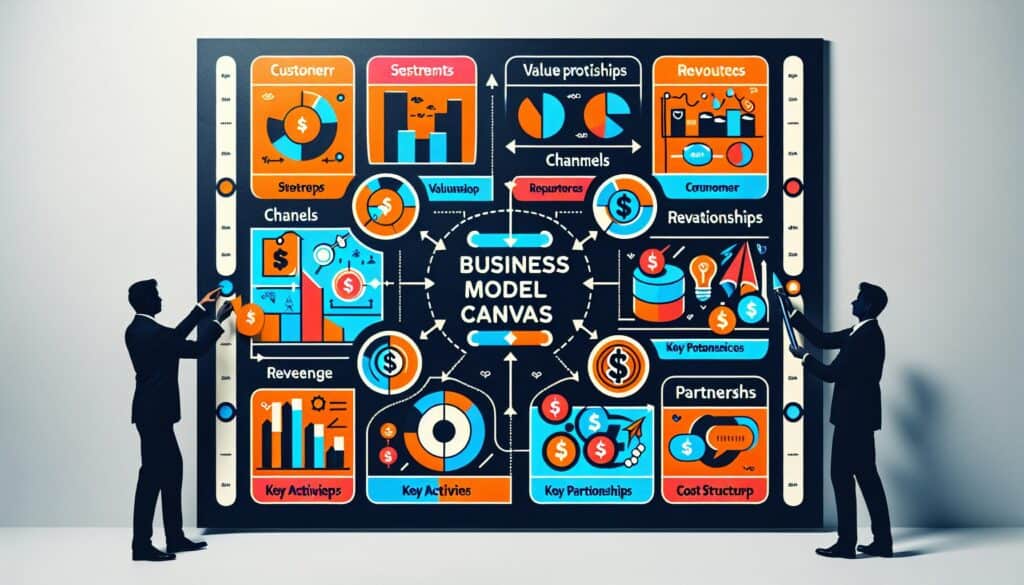To visually describe, design, challenge, and pivot a business model through nine key building blocks: customer segments, value propositions, channels, customer relationships, revenue streams, key resources, key activities, key partnerships, and cost structure.
- Methodologies: Engineering, Ergonomics
Business Model Canvas

Business Model Canvas
- Agile Methodology, Cross-Functional Collaboration, Customer Experience, Design Thinking, Innovation, Lean Manufacturing, Project Management, Value Proposition
Objective:
How it’s used:
- Entrepreneurs and strategists use it as a shared language to map out existing business models or develop new ones, facilitating strategic conversations and innovation.
Pros
- Provides a holistic view of the business, simple and visual, facilitates communication and collaboration, encourages systematic thinking.
Cons
- Can be too simplistic for complex businesses, doesn't inherently validate assumptions (requires external testing), can be static if not regularly updated.
Categories:
- Economics, Ideation, Product Design, Project Management
Best for:
- Developing, visualizing, and iterating on new or existing business models in a structured and collaborative way.
The Business Model Canvas serves various applications across sectors such as technology, healthcare, and consumer goods, making it versatile for both startups and established enterprises looking to innovate or pivot. Organizations often use it in early project phases, such as ideation and feasibility studies, where cross-functional teams—including designers, engineers, and marketers— collaborate to explore new product offerings or refine existing ones. This methodology allows for the development of customer personas and value propositions, grounding discussions in real user needs and market challenges, which is particularly valuable in design thinking initiatives. Participants can work through issues related to revenue streams, distribution channels, and customer relationships, integrating stakeholder feedback directly into the model. Industries like fintech leverage the canvas to visualize complex regulatory requirements alongside innovative service delivery mechanisms, while companies in sustainable energy focus on environmental impacts and social value. The structure of the canvas encourages iteration, enabling teams to quickly adapt their approaches based on testing or market feedback, making it a dynamic tool for planning and strategy alignment. In workshops, the Business Model Canvas creates an engaging environment, where ideas can be swiftly sketched out and explored, leading to enhanced communication and collaboration within diversely skilled teams.
Key steps of this methodology
- Identify customer segments and define target groups.
- Clarify value propositions for each customer segment.
- Outline channels for customer communication and delivery.
- Specify customer relationships and engagement strategies.
- Detail key revenue streams from each segment.
- Identify key resources required to deliver the value propositions.
- List key activities that must be performed to create value.
- Define key partnerships that enhance business capabilities.
- Establish the cost structure associated with the business operations.
Pro Tips
- Integrate metrics directly into the canvas; quantify each segment for a clear understanding of performance and value generation.
- Conduct regular "Canvas Jam" sessions with cross-functional teams to encourage diverse perspectives and innovative ideas.
- Utilize digital tools to create an interactive Business Model Canvas that allows real-time updates and stakeholder engagement during brainstorming sessions.
To read and compare several methodologies, we recommend the
> Extensive Methodologies Repository <
together with the 400+ other methodologies.
Your comments on this methodology or additional info are welcome on the comment section below ↓ , so as any engineering-related ideas or links.
Historical Context
1960
1980
1983
1990
1995
2000
2010
1950
1980
1980
1986
1994
1995
2000
(if date is unknown or not relevant, e.g. "fluid mechanics", a rounded estimation of its notable emergence is provided)














Related Posts
Monte Carlo Simulation
Model-Based Testing
Model Checking
Mixed Methods Research
Mistake Proofing (Poka-Yoke)
Mission Profile Testing